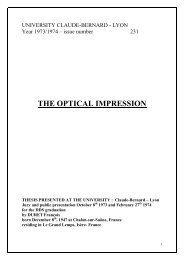english version(pg40to78) - Pr. François Duret
english version(pg40to78) - Pr. François Duret
english version(pg40to78) - Pr. François Duret
Create successful ePaper yourself
Turn your PDF publications into a flip-book with our unique Google optimized e-Paper software.
F <strong>Duret</strong> and Coll. <strong>Pr</strong>incipes de fonctionnement et applications techniques de l’empreinte optique dans l’exercice de cabinet<br />
(traduction Anglaise)<br />
Page 102<br />
TOOL MACHINE<br />
Masterpiece, it represents a concretisation of the virtual work executed<br />
by the practioner with the CAM, the tool machine executes orders<br />
from the CNC. It is about a mechanical organ carrying the work’s<br />
execution tool 29 . The manufacturing micro-centres mix rigidity of the<br />
structure of the drills and flexibility of the big centres use. They<br />
represent the movements in X, y and Z corresponding to the volumes<br />
of the work to be done inside the mouth. The power of the brooch<br />
engines, their rotation speed and the brooch’s torque must be chosen<br />
wisely depending on the type of work and the materials imposed to the<br />
technology. The machines with 3 axes have a good definition to attack<br />
the dental market (2 axes and a half seem a little restrictive). The tries<br />
we have presented at the Garancière 30, 31 were done on a Mutan 2000<br />
tool machine from Etecma which presented the following<br />
characteristics:<br />
Run: 150 x 200 x 100<br />
<strong>Pr</strong>ecision: (dimension 2), 400 card: 25µm<br />
Brooch speed: 1 to 10 on an engine power of 0.75kW and for a<br />
cylinder drill of 4.5mm diameter.<br />
CNC from ICN-Synthèse…<br />
The program defined a premolar in 400 points spread over 26 cut<br />
levels (2.5 axes), that is to say a 500µm precision in X, Y and a<br />
250µm precision in Z (Fig 38).<br />
The extrados had a precision of ± 25µm every 500µm in X and Y and<br />
every 250µm in Z. Given the precision in Z and that the curves are<br />
Splin functions, it isn’t wrong to think that the precision was ± 200µm<br />
over the whole tooth (biological curves). This precision, too low in<br />
our opinion, stopped the creation of a correct cusp relief (Fig 39).<br />
It took 4mn of manufacturing to execute the piece by using a reduce<br />
speed for movements.<br />
The polishing, to get the same finish as our current prostheses, lasted<br />
17 seconds (very fast because of the precision of material removal).<br />
The manufacturing of the internal part or intrados must be executed on<br />
the same piece after it has had a 180° rotation.<br />
Les Cahiers de <strong>Pr</strong>othèse (50) pp 73 – 110, 1985



